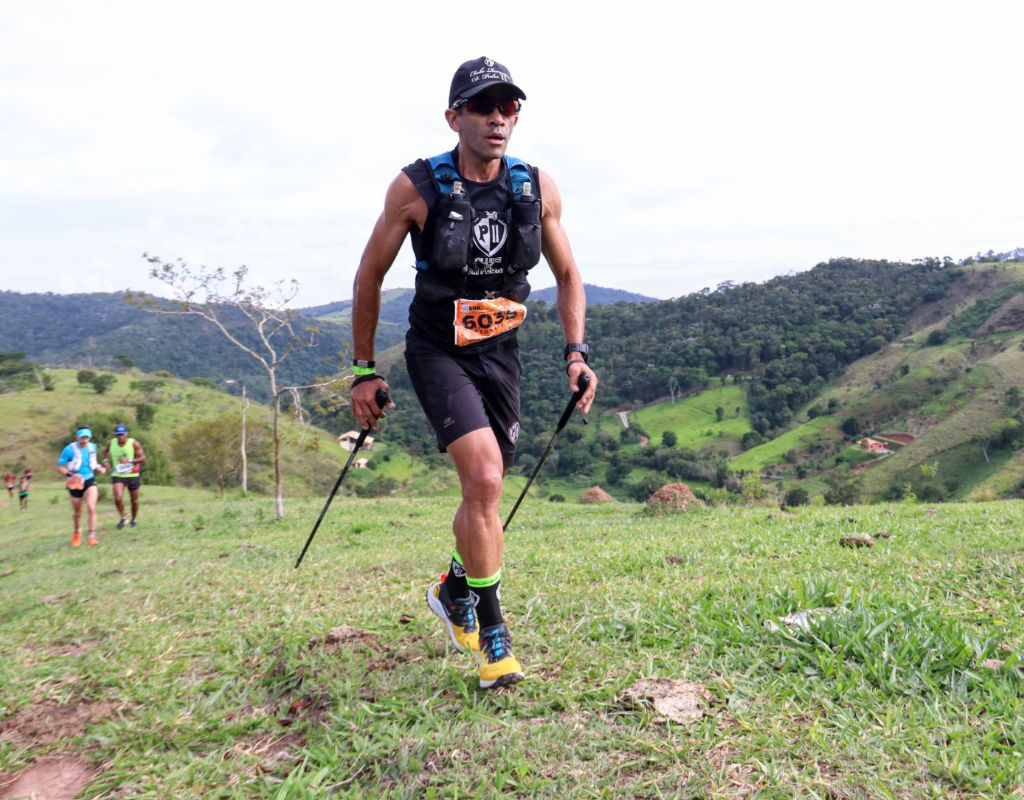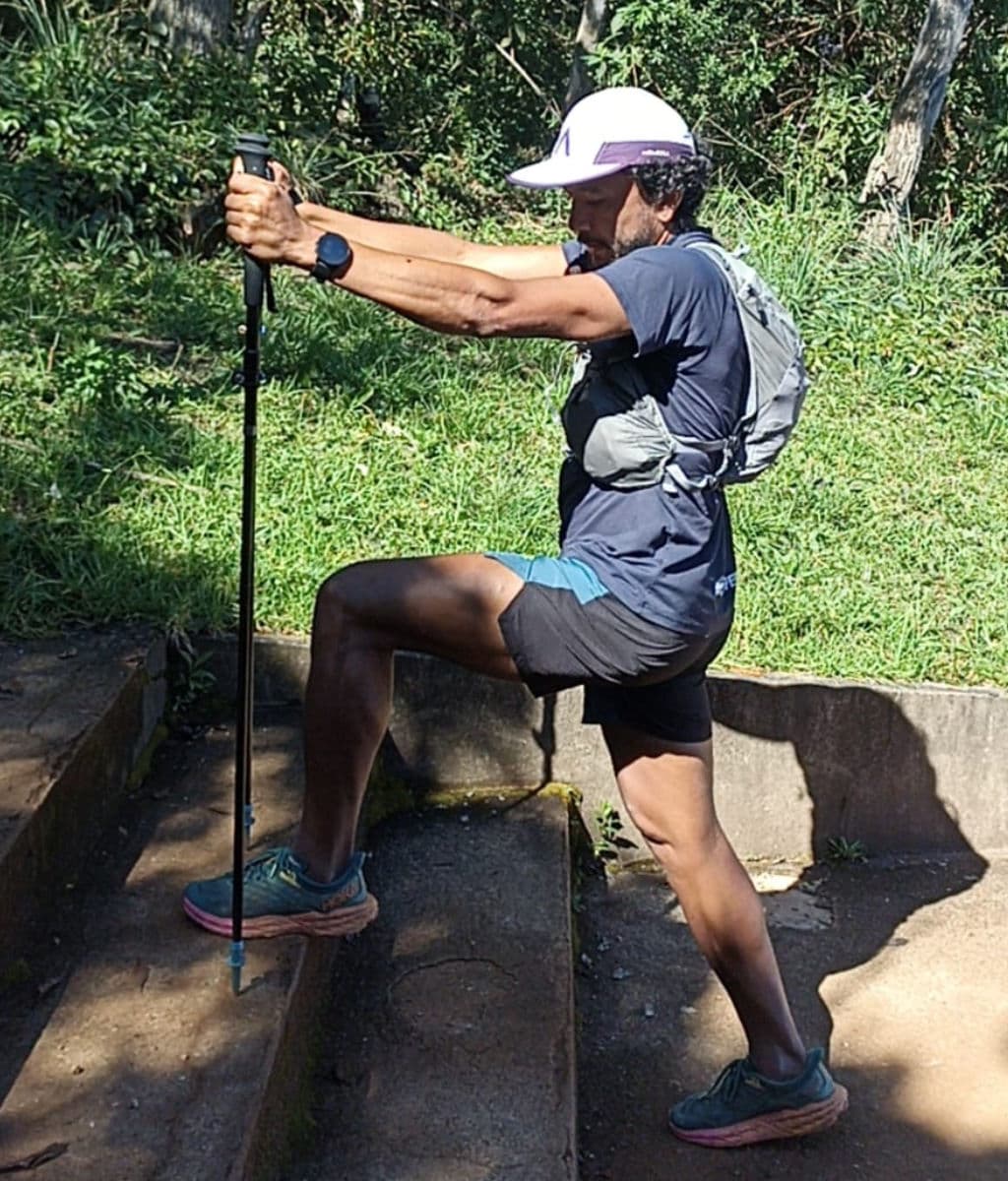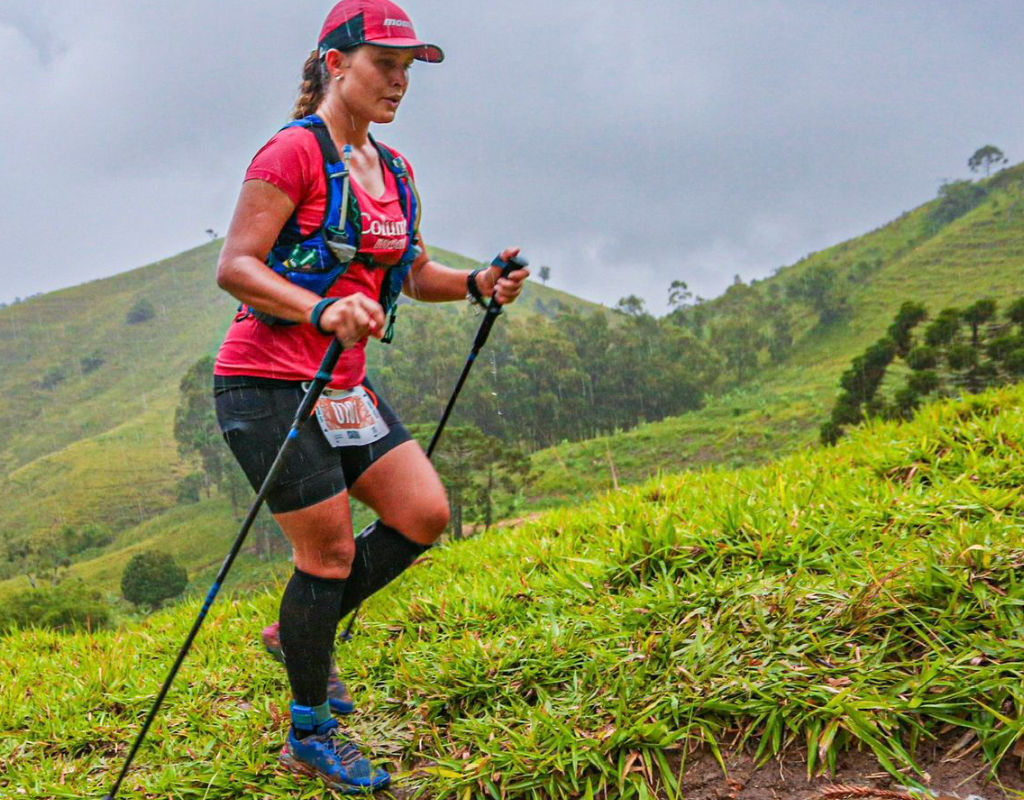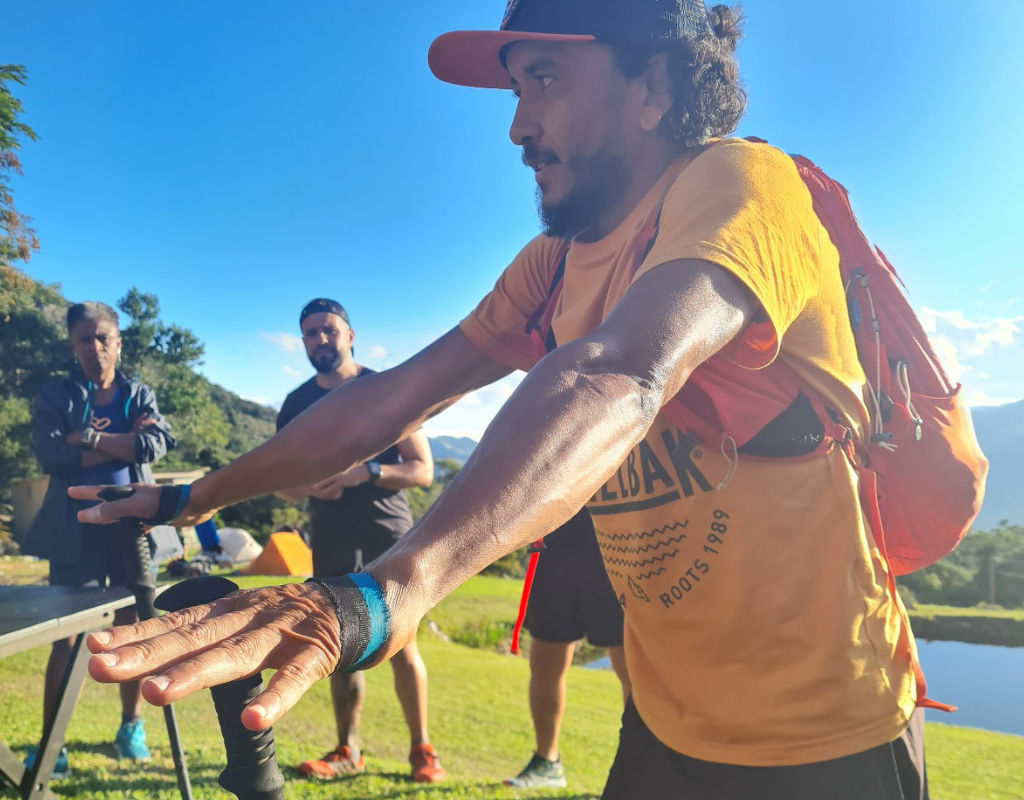Using poles in trail running helps athletes save their lower limbs during long runs, especially on uphill sections, while also improving speed and performance. However, training is required to ensure optimal performance, prevent falls, and avoid cramps in the upper limbs.
In this article, we provide a guide on the correct use of trail running poles, efficient techniques for uphill, downhill, and flat terrain, insights from athletes and coaches, and recommendations for models and brands.
The Role of Poles in Trail Running
Common in Europe, where they are used in various snow activities, poles are becoming increasingly popular in Brazil among trail runners. Their primary function is to help runners conserve energy and reduce strain on the lower limbs on uneven, hilly terrain—and even on slightly inclined flat sections in long-distance races—enhancing performance.
“Poles are propulsion tools. Simply planting them on the ground won’t serve their purpose, which is to improve average times on trails by minimizing leg energy expenditure and preserving muscle strength so you can maintain or even increase speed toward the end of the race,” explains ultramarathoner Ernani de Souza.

André Medeiros, athlete and national tour guide, says pole usage is highly flexible. “You can use them to navigate rocks, rivers, or small streams. If you encounter tiny stones, for example, positioning the poles on the sides helps maintain balance while overcoming obstacles.”
Benefits of Using Poles:
- Uphill: Distributing effort between lower and upper limbs increases speed and performance while conserving energy.
- Flat terrain: Poles help facilitate faster strides or runs on uneven ground.
- Downhill: They provide stability and balance, though proper technique and caution are essential to avoid accidents.
Differences Between Trekking and Trail Running Poles
Trekking involves hiking with stops and overnight camping, often requiring larger backpacks. As a result, weight, transportability, and ease of setup are less critical since poles are used more frequently.
In trail running, however, carried weight impacts performance, necessitating lighter poles. Another key difference is that trail runners frequently stow and retrieve poles from backpacks or belts, requiring quick-release mechanisms for fast deployment. Thus, trail running poles should be lightweight, compact, and feature rapid-lock systems. These traits ensure runners don’t lose time during races or training.
“In trail running, we always consider weight and how poles are stored since they’re rarely used throughout the entire course. Another point is that running poles are thinner,” explains Isadora Martins, athlete, coach, and founder of the Elas na Trilha project.
How to Choose Trail Running Poles
The market offers various models and brands with different weights, heights, and materials. Here’s what you need to know to pick the right type:
Size: For practicality during runs, opt for fixed-length poles rather than adjustable telescopic ones. Size should match your height—some brands provide sizing charts, but testing in-store is ideal.
Ultramarathoner Ernani de Souza recommends this method for calculating the ideal length: “Stand on flat ground with elbows bent at 90 degrees. Add 5 cm to this measurement for the average pole length you should buy.”
Also, consider folded length to ensure poles fit securely in backpacks or belts without protruding, which could snag branches or pose risks to others. Three- or four-section folding poles are common, with tri-fold being the most popular.
Carbon vs. Aluminum: Poles are made of aluminum or carbon fiber. The difference lies in weight and price, with aluminum being more affordable. For ultralight gear, carbon is preferable, reducing carried weight during races.
Straps: Most poles feature wrist straps for secure handling, though newer models include glove-like attachments with quick-release clips. “Straps prevent poles from lagging if they catch on rocks or mud. Another tip: grip the pole lightly and rely on straps for support. Squeezing too hard wastes arm, forearm, and shoulder energy,” explains Ernani.
How to Use Poles on Flat, Uphill, and Downhill Terrain
Virginio, mountain running athlete, coach, and technical director of JVM Trail Run
Proper pole technique minimizes leg strain by distributing effort to arms and shoulders. Training regularly on varied terrain is key.
Best practices recommended by athletes and coaches:
The most common technique, especially on slightly inclined dirt roads, alternates legs and arms—propelling opposite limbs simultaneously without extending poles beyond foot placement, which creates resistance. The motion should be rhythmic: left leg forward, right arm forward.
“I use this technique even at the start of races when legs are fresh. While less impactful than on steep climbs, it still helps conserve leg energy and trains coordination. Saving just 1% of leg energy in the first third of a race means finishing stronger,” says Ernani de Souza.

Uphill Techniques
The alternating technique works for runnable inclines, while steeper climbs may require planting both poles ahead and taking one to three steps before repositioning. “This engages shoulders and triceps more,” explains Chico Santos, athlete and founder of CS Experience.
Proper form involves extending knees, hips, and elbows simultaneously to drive upward, preserving muscle strength for long descents.

Downhill Techniques
Poles stabilize hips on descents, improving balance. “If you jump over a rock while shifting left, poles help maintain equilibrium. After 10–15 hours of racing, this makes a difference,” says André Medeiros.
However, downhill use requires extra caution. “On climbs, terrain is easier to reach. On descents, it’s farther away, requiring slight torso lowering—risky on uneven trails where rocks and branches can dislodge or break poles,” warns Chico Santos.
Ultramarathoner Ernani de Souza adds, “Poles aid balance but are fragile. Overloading them risks breakage and injury.”
When to Use Poles
In long-distance races with extended elevation changes, poles help reduce fatigue and conserve energy. “Imagine a 100 km race with three 10 km climbs. Poles save muscle strength for descents,” says Chico Santos.
Isadora Martins, who favors high-elevation races, recommends poles for runners increasing distances: “Beyond 20 km with significant elevation? Poles help tremendously. I timed a 500 m climb with and without poles—the difference was huge. Saving 30 seconds per segment adds up in a 50 km race.”
For races with frequent ups and downs, poles may be impractical due to constant stowing and retrieval, increasing accident risks. André Medeiros cites the WTR CamelBak Le Canton in Teresópolis: “A rollercoaster-like course! Poles aren’t worth the hassle here.”

Technical descents with roots and mud can also be hazardous. “If you fall, poles may puncture ribs or legs,” warns Chico Santos.
Train to Maximize Pole Performance
André Medeiros, athlete and national tour guide
Efficient pole use requires regular training to avoid cramps and mishaps.
Ernani recalls early struggles: “I rarely trained with poles and fumbled during races, tripping over them. I fell a few times.”
Isadora Martins notes that proficiency takes about three months, especially for urban runners accessing trails only on weekends.

Upper-body strength training (arms, forearms, trapezius, shoulders) is also crucial. “Early on, forearm cramps are common. Train pole positioning and strengthen relevant muscles, especially triceps,” advises Isadora.
Chico Santos emphasizes propulsion efficiency: “Poles shouldn’t just support—they must drive you forward, requiring arm strength training.”

Practice Deploying Poles Quickly
Poles shouldn’t distract from the trail, so practice retrieving and assembling them swiftly while moving. Actions should become automatic to avoid stopping mid-run.
During the OCC – UTMB Mont Blanc, Ernani ran six hours with poles extended due to poor belt fit. “I trained with poles but didn’t practice stowing them. My makeshift belt shook violently during descents, forcing me to carry them mounted. I finished with arm cramps.”
For long races, also rehearse eating and drinking while holding poles.
Top Brands Recommended by Trail Runners and Coaches
One of the most globally trusted brands, according to athletes, is Black Diamond. Recommended models include the DISTANCE CARBON Z and WOMEN’S DISTANCE CARBON Z (tri-fold, 100% carbon), and the aluminum DISTANCE Z.
Another rising brand is Germany’s Leki, favored for its ergonomic grips. Instead of straps, some models feature lightweight, breathable gloves with quick-release clips. Top picks: ULTRATRAIL FX.ONE SUPERLITE, EVOTRAIL FX.ONE TA, and the strap-based NEOTRAIL PRO FX.ONE SUPERLITE.
Budget-Friendly Options
EVADICT poles by Decathlon offer carbon fiber construction and quick-lock mechanisms at affordable prices. Aluminum models are also available.
Brazil’s Kailash TREKKER KTR provides tri-fold aluminum poles with replacement part kits for maintenance.
Invest in Pole Training to Boost Trail Running Performance
As we’ve seen, trail running poles enhance performance, conserving energy for stronger finishes. Training and proper technique on climbs, descents, and flats ensure efficiency, safety, and injury prevention.
This post is also available in: Português (Portuguese (Brazil)) Español (Spanish)
